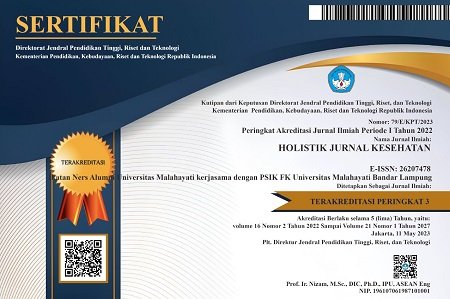Penurunan kecemasan dan nyeri melahirkan secara normal melalui penerapan deep breathing exercise dan musik relaksasi
Abstract
Background: Childbirth is a process that a woman must go through to become a mother. The birthing process often causes feelings of fear and anxiety about the pain that is felt, resulting in the mother not being calm about childbirth and hampering the birthing process itself. Many non-pharmacological treatments for anxiety and pain have been developed to create a pleasant birth experience, such as hypnotherapy, massage, hot and cold compresses, relaxation techniques.
Purpose: To determine the effect of deep breathing exercise and relaxation music on reducing anxiety levels and intensity of delivery pain.
Method: Quasi experiment with two group comparison pretest-posttest design approach with 30 respondents taken based on consecutive sampling technique and divided in 2 groups, 15 respondents for the deep breathing exercise group and 15 respondents for the relaxation music group. Research location at BPM Pelita Kasih in March-June 2023. Statistical tests use the Dependent sample T-Test. Data collection used the STAI instrument to assess anxiety levels and the VAS instrument to assess pain intensity
Results: Research shows that there is an effect of deep breathing exercise and relaxation music on reducing the intensity of delivery pain with a p-value in the deep breathing exercise group = 0.03 and in the relaxation music group <0.01. Meanwhile, analysis of anxiety levels showed that there was no effect of deep breathing exercise and relaxation music with a p-value = 0.475 for the deep breathing exercise group and 0.359 for the relaxation music group.
Conclusion: Deep breathing exercise and relaxation music can reduce the intensity of delivery pain so that when applied to every pregnant woman, it is hoped that it can provide a pleasant labour experience.
Keyword: Anxiety; Deep Breathing Exercise; Delivery Pain; Relaxation Music
Pendahuluan: Melahirkan secara normal merupakan suatu proses yang harus dilalui oleh seorang wanita untuk menjadi seorang ibu. Proses melahirkan secara normal tidak jarang menimbulkan perasaan takut dan cemas akan nyeri yang dirasakan sehingga mengakibatkan ibu tidak tenang menghadapi melahirkan secara normal dan menghambat proses melahirkan secara normal itu sendiri. Penanganan cemas dan nyeri secara non farmakologi sudah banyak dikembangkan untuk mewujudkan pengalaman bersalin yang menyenangkan seperti hipnoterapi, massage, kompres panas dan dingin, teknik relaksasi.
Tujuan: Untuk mengetahui pengaruh deep breathing exercise dan musik relaksasi terhadap penurunan tingkat kecemasan dan intensitas nyeri melahirkan secara normal.
Metode: Quasi eksperimen dengan pendekatan two group comparison pre-test dan post-test design dengan 30 responden yang diambil berdasarkan teknik consecutive sampling dan ke dalam 2 kelompok, 15 responden untuk kelompok deep breathing exercise dan 15 responden untuk kelompok musik relaksasi. Lokasi penelitian di BPM Pelita Kasih pada Maret-Juni 2023. Uji statistik menggunakan uji T-Test Dependen. Pengumpulan data menggunakan instrument STAI untuk menilai tingkat kecemasan dan instrument VAS untuk menilai intensitas nyeri.
Hasil: Penelitian menunjukkan bahwa terdapat pengaruh deep breathing exercise dan musik relaksasi terhadap penurunan intensitas nyeri melahirkan secara normal dengan nilai p-value pada kelompok deep breathing exercise yaitu 0.03 dan pada kelompok musik relaksasi yaitu <0.01. Sedangkan analisis terhadap tingkat kecemasan menunjukkan tidak ada pengaruh deep breathing exercise dan musik relaksasi dengan nilai p-value yaitu 0.475 untuk kelompok deep breathing exercise dan 0.359 untuk kelompok musik relaksasi.
Simpulan: Deep breathing exercise dan musik relaksasi dapat menurunkan intensitas nyeri melahirkan secara normal sehingga apabila diterapkan pada setiap ibu hamil diharapkan dapat memberikan pengalaman melahirkan secara normal yang menyenangkan.
Keywords
References
Barrios, Y., Sanchez, S., Qiu, C. F., Gelaye, B., & Williams, M. (2014). Risk of spontaneous Preterm Birth in Relation to Maternal Experience of Serious Life Events During Pregnancy. International Journal of Women’s Health, 249–257.
Fisher, C., Hauck, Y., Bayes, S., & Byrne, J. (2012). Participant Experiences of Mindfulness-Based Childbirth Education: A Qualitative Study. BMC Pregnancy and Childbirth, 1–10.
Hayat, A. (2017). Kecemasan dan Metode Pengendaliannya. Khazanah: Jurnal Studi Islam dan Humaniora, 12(1). 52-63. https://doi.org/10.18592/khazanah.v12i1.301
Herinawati, H., Hindriati, T., & Novilda, A. (2019). Pengaruh Effleurage Massage terhadap Nyeri Persalinan Kala I Fase Aktif di Praktik Mandiri Bidan Nuriman Rafida dan Praktik Mandiri Bidan Latifah Kota Jambi. Jurnal Ilmiah Universitas Batanghari Jambi, 19(3), 590-601.
Hernawati, E. B. M. A. (2018). Implementasi Risiko Pengurangan Kecemasan Ibu Bersalin Kala I Melalui Metode Hipnobrithing di Klinik Bersalin Gegerkalong Kota Bandung. Jurnal Bidan, 4(2), 73–78. https://media.neliti.com/media/publications/267038-implementasi-pengurangan-resiko-kecemasa-92d49431.pdf
Istikhomah, H., & Murwati, M. (2016). Pengaruh Terapi Relaksasi Nafas Dalam Terhadap Tingkat Kecemasan dan Lama Persalinan Kala I dan II Di BPM Wilayah Klaten. Interest: Jurnal Ilmu Kesehatan, 5(1).
Kulkarni, S., & Sia, S. T. (2014). Hazards of Labour Pain and The Role of Non-Neuraxial Labour Analgesia. Trends in Anaesthesia and Critical Care, 4(4), 109-114. https://doi.org/10.1016/j.tacc.2014.04.009
Livana, P. H., Handayani, T. N., Mubin, M. F., & Ruhimat, I. I. A. (2020). Efektifitas Terapi Musik pada Nyeri Persalinan Kala I Fase Laten. Jurnal Ners Widya Husada, 4(2), 47-52.
Parung, V. T., Novelia, S., & Suciawati, A. (2020). Pengaruh Terapi Musik Klasik Terhadap Kecemasan Ibu Bersalin Kala I Fase Laten Di Puskesmas Ronggakoe Manggarai Timur Nusa Tenggara Timur. Asian Research of Midwifery Basic Science Journal, 1(1), 119–130. https://doi.org/10.37160/arimbi.v1i1.584
Putri, E. R. T., & Margaretta, S. S. (2021). Efektifitas Relaksasi Deep Breathing Dengan Teknik Self Intruction Training (SIT) Dalam Bentuk Video Dan Audio Untuk Mengurangi Kecemasan Pada Ibu Hamil. Jurnal Keperawatan dan Kesehatan Masyarakat Cendekia Utama, 10(1), 26-33.
Ramlah, R., Bustan, M. N., & Arman, A. (2023). Pengaruh Terapi Murrotal Al-Quran dan Slow Deep Breathing terhadap Intensitas Nyeri Pada Ibu Bersalin di Wilayah Kerja Puskesmas Tandrutedong Sidrap. Journal of Muslim Community Health, 4(4), 171-179.
Sari, D. P., Rufaida, Z., & Lestari, S. W. P. (2018). Nyeri Persalinan. Sekolah Tinggi Ilmu Kesehatan Majapahit, 1-30.
Sidabukke, I. R. R., & Siregar, R. N. (2020). Faktor-Faktor yang Mempengaruhi Kecemasan Pada Ibu Bersalin di Rumah Sakit Restu Medan. Journal of Healthcare Technology and Medicine, 6(1), 276-284.
Simanjuntak, M. K. (2022). The Effect of Birthing Ball for Anxiety and Pain in Labour. Jambura Journal of Health Sciences and Research, 4, 22–28. https://doi.org/10.35971/jjhsr.v4i0.12541
Smith, C. A., Levett, K. M., Collins, C. T., Armour, M., Dahlen, H. G., & Suganuma, M. (2018). Relaxation Techniques for Pain Management In Labour. Cochrane Database of Systematic Reviews, (3). https://doi.org/10.1002/14651858.CD009514.pub2.www.cochranelibrary.com.
Sundariningsih, S., Raksanagara, A. S., & Suardi, A. (2021). Efektivitas Hipnoterapi Terhadap Penurunan Nyeri Kala I Fase Aktif Parturien Primigravida Di Praktik Mandiri Bidan. Jurnal Sistem Kesehatan, 6(1).
Taavoni, S., Sheikhan, F., Abdolahian, S., & Ghavi, F. (2016). Birth Ball or Heat Therapy? A randomized Controlled Trial to Compare The Effectiveness of Birth Ball Usage With Sacrum-Perineal Heat Therapy in Labour Pain Management. Complementary Therapies in Clinical Practice, 24, 99–102. https://doi.org/10.1016/j.ctcp.2016.04.001
Wan, Q., & Wen, F. (2018). Effects of Acupressure and Music Therapy on Reducing Labour Pain. International Journal of Clinical and Experimental Medicine, 11(2), 898–903.
Whitburn, L. Y., Jones, L. E., Davey, M., & Small, R. (2017). The meaning of Labour Pain: How The Social Environment and Other Contextual Factors Shape Women’S Experiences. 1–10. https://doi.org/10.1186/s12884-017-1343-3
Widyaningsih, H., & Yustantina, R. (2023). Penerapan (Dbm-Db) Deep Back Massage dan Deep Breathing Terhadap Penurunan Nyeri Persalinan Kala I Fase Aktif di Ruang Anyelir RSUD dr. R. Soeprapto Cepu. Jurnal Ilmu Keperawatan Maternitas, 6(1), 1–12. https://doi.org/10.32584/jikm.v6i1.2133
DOI: https://doi.org/10.33024/hjk.v17i6.12164
Refbacks
- There are currently no refbacks.
Copyright (c) 2023 Holistik Jurnal Kesehatan

This work is licensed under a Creative Commons Attribution-NonCommercial 4.0 International License.














